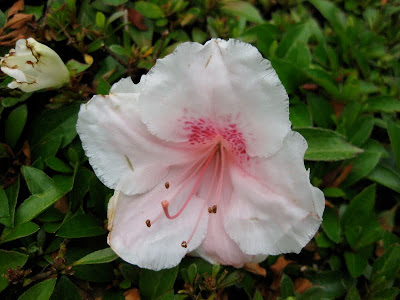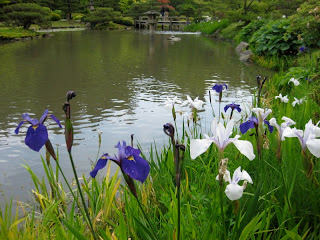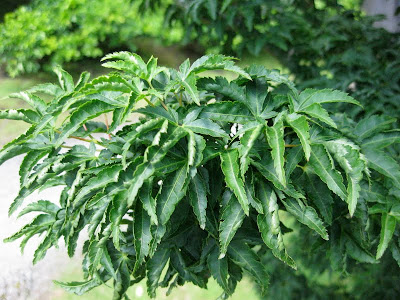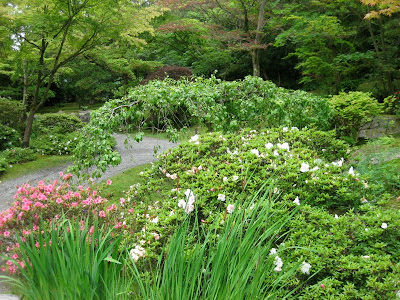• PLUS the link to main Seattle Japanese Garden Community Blog here: SJGCB
• Caught in bloom:
Kathy asked that before: it this Rhododendron Wada hybrid, azalea?
Area O lists 3 of them as 32", corolla white... I actually counted 4 of them on in the area O, 3 at the bottom of on the path to Kobe lantern, and one higher up L side of the stone path. When you look closely, they are actually not quite white, as they have pink blotches/lines here and there (see pics below), but overall look IS white.
 |
| SJG • 6/29/11 - Rhododendron Wada hybrid, azalea? |
 |
| SJG • 6/29/11 - Rhododendron Wada hybrid, azalea? close-up |
 |
| SJG • 6/29/11 - Rhododendron Wada hybrid, azalea? close-up |
• Spirea japonica 'Alpina', Alpine spirea:
Pattie, the SJG Gardener, was on the ladder and clearing the spent azaleas' blooms on the end of E path, where I noticed some purple blooms, about knee high. I asked her if she knew the name of them, and she said 'yes, spirea'.
 |
| SJG • 6/29/11: Spirea japonica 'Alpina', Alpine spirea; almost on the end of E path, Area M |
 |
| SJG • 6/29/11: Spirea japonica 'Alpina', Alpine spirea; close-up, Area M |
• Philyrea latifoliamedia media , Philyrea:
While I was consulting the 'Plant Book' about spirea, Pattie said she always wondered about the weird plant next to illex creanata (Japanese holly) on the end of the E path - what is it? So we looked and found this description: 'opposite serrated leaves'. That's it!
 |
| SJG • 6/29/11 - Philyrea latifoliamedia media , Philyrea (L bush, next to Japanese holy R); Area K |
 |
| SJG • 6/29/11 - Philyrea latifoliamedia media , Philyrea - close-up, Area K |
• Viburnum plicatum, Japanese snowball bush:
 |
| SJG 6/29/11 • Viburnum plicatum, Japanese snowball bush; W side of the E path, Area F |
 |
| SJG 6/29/11 • Viburnum plicatum, Japanese snowball bush, flower |
• Comus kousa 'Chinensis', Korean Dogwood:
 |
| SJG 6/29/11 • Comus kousa 'Chinensis', Korean Dogwood, E side of the E path, Area D |
 |
| SJG 6/29/11 • Comus kousa 'Chinensis', Korean Dogwood, flower, Area D |
• Rhododendron ?, azalea:
Found it blooming, thought it would be easy to identify, but not - about 4 azaleas roughly matching on the list, have no clue which one is it. Googling images didn't help, because many come in several colors - to be checked next year - here just a proof it bloomed the end of June:
 |
| SJG 6/29/11 • Rhododendron ?, azalea, Area Z |
 |
| SJG 6/29/11 • Rhododendron ?, azalea, Area Z |
• Also observed today: 'Jindai', Azalea - progressed in bloom (i will post it also where it was originally noted):
 |
| SJG 6/29/11 • Rhododendron 'Jindai', Azalea - corolla white with pink sectors; Area X. |
• Ro getsu azalea also progressed:
 |
| SJG 6/29/11 • Rhododendron 'Ro Getsu', azalea - corolla white with pink sectors; Area O |
• Jindai & J. T. Lovett azaleas also progressed:
 |
| SJG 6/29/11 • 'Jindai' (close) and 'J.T. loved (far) finally blooming; Area H |
 |
| 6/29/11 • Jindai, up-close, Area H |
 |
| 6/29/11 • Jindai, up-close, Area H |
 |
| SJG 6/29/11 • J.T. Lovett, close-up, Area H |
• More unidentified azaleas half-way on the path to Kobe lantern, now in bloom, kind of two-tone, some flowers white, some pink:
 |
| SJG 6/29/11 • Unidentified azaleas, Area O |
 |
| SJG 6/29/11 • Unidentified azaleas, Area O, close-up |
 |
| SJG 6/29/11 • Unidentified azaleas, Area O, close-up |
• On Japanese iris:
our previous Master Gardener, Kathy, provided a list of Japanese iris added last winter:
Gracieuse
Shogun
Double Delight
Geisha Girl
Temple Bells
Picotee Wonder
Cry of Rejoice
Henry’ White
Jedojima
variegate
My Fuji
Asked for help to identify which is which, Kathy wrote:
We many different varieties and mixed them up in all the beds as per Masa’s suggestion. Some varieties were too delicate and died off. To make accuracy more difficult, when I ordered them, there weren’t any photos and they weren’t blooming. I tried to make sure that the combinations matched by the descriptions so the planting would stay harmonious. So it would be very difficult to get an accurate count on what is there. If you want to list the varieties I would suggest that there are “iris beds containing the following varieties ---, ---,----, etc. .“
I just wanted this info to be preserved, which is why I'm posting it here, but I'll leave it at that for now, and perhaps research it some time later.





























